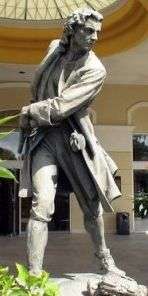Battle of Nassau (1720)
| Raid on Nassau | |||||||
|---|---|---|---|---|---|---|---|
| Part of the War of the Quadruple Alliance | |||||||
 Statue of Woodes Rogers outside the British Colonial Hotel, Nassau | |||||||
| |||||||
| Belligerents | |||||||
|
|
| ||||||
| Commanders and leaders | |||||||
|
|
| ||||||
| Strength | |||||||
|
3 frigates, 9 sloops, 1,200 militia |
2 frigates, 500 militia | ||||||
The Raid on Nassau (or Battle of New Providence) took place in February 1720 when a Spanish force attempted to assault the British settlement of Nassau during the War of the Quadruple Alliance.
The Spanish force of 1,200 was largely drawn from Cubans and commanded by Francisco Cornejo. The threat of Spanish invasion had bedeviled New Providence for the past year, halting settlement on the island and prompting the construction of Fort Nassau, with 50 guns and 250 defenders. Initial plans for an attack on the city from Nassau Harbour were forestalled by the discovery of two British warships in the harbour: the governor's flagship, Delicia (32), and the frigate HMS Flamborough (24). Spain's heavy ships of the line sat too deep for the harbour's shallow waters. Cornejo opted to bypass the city and the Spanish squadron crept ahead east along Hog's Island, landing three columns and seizing large amounts of plunder before being repelled by Governor Woodes Rogers's 500 militia. The Spanish ships remained in the bay for some time before retiring.[2]
Cornejo eventually set sail relatively unharmed, with over 100 captured slaves. Rogers, unable to pay the garrison and his health failing, set sail for England soon afterward. The governor had expended his personal fortune on Nassau's defenses, which had been the source of considerable anxiety and depression. Britain and Spain negotiated peace the following year.
References
Bibliography
- Marley, David. Wars of the Americas: a chronology of armed conflict in the New World, 1492 to the Present. ABC-Clio, 1998.
- Little, Brian (1960), Crusoe's Captain, Odhams Press
- Riley, Sandra (2000), Homeward Bound: A History of the Bahama Islands to 1850 with a Definitive Study of Abaco in the American Loyalist Plantation Period, Riley Hall